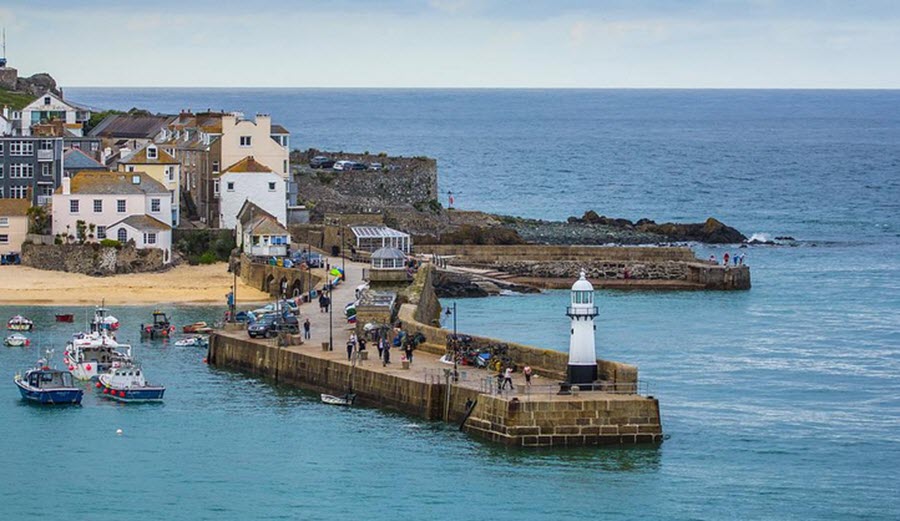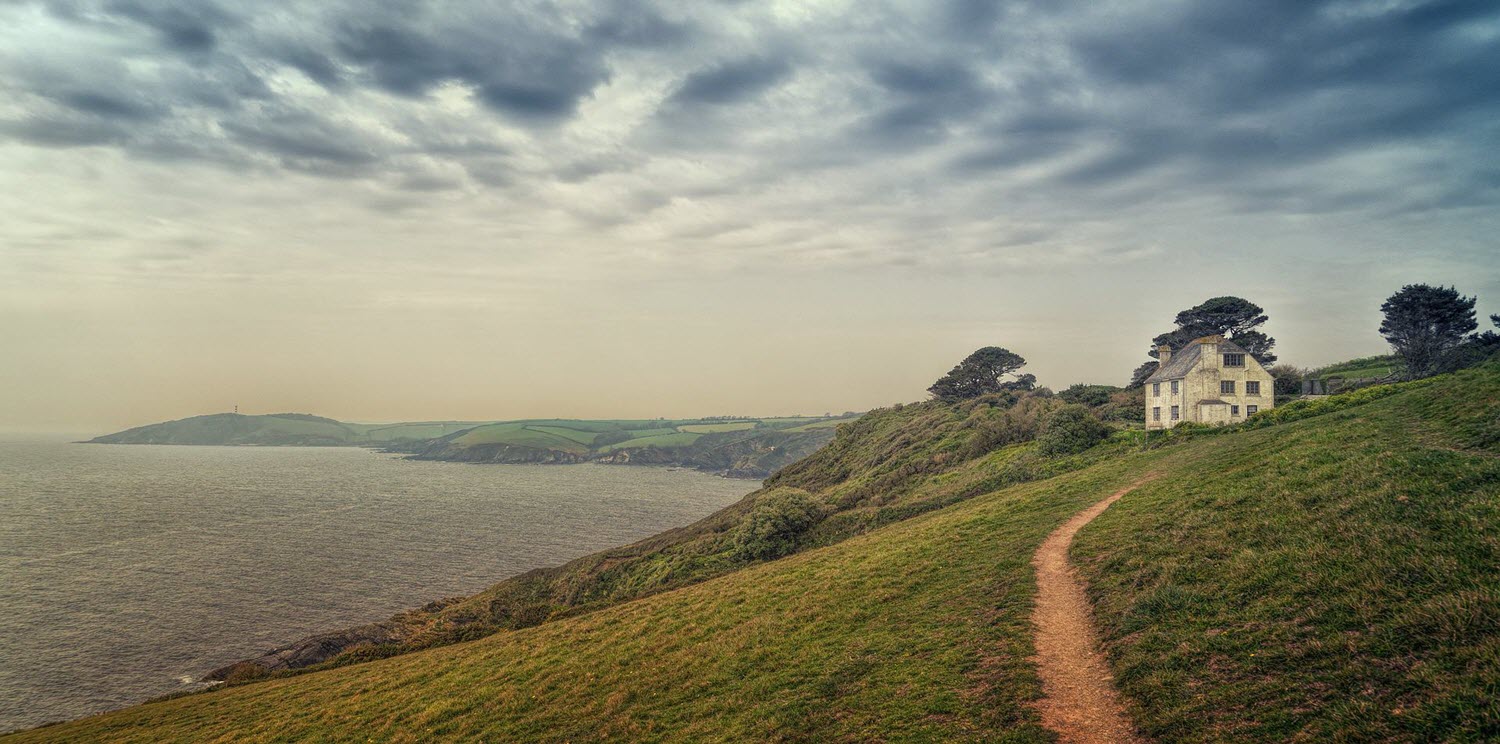Located in South West England, Cornwall is a historic and ceremonial county recognised as one of the Celtic nations and the heartland of the Cornish people. Cornwall jets out into the Atlantic ocean and is only connected with the rest of the English mainland in the east, where it borders the county of Devon. Most of this border is comprised of the River Tamar.
Once upon a time, Cornwall was a Brythonic kingdom, before becoming a royal duchy. In 2014, the Cornish people were granted minority status under the European Framework Convention for the Protection of National Minorities, which recognized them as a distinct ethnic group.
Cornwall´s interesting history, unique culture, and spectacular landscape has made it a popular tourist destination. Even as early as the 1800s, people flocked to the Cornish beaches to enjoy life by the sea. Cornwall has many miles of beaches and cliffs, and beautiful seaside settlements, but is also home to extensive moorlands and grand farming landscapes. In an average year, around five million people visit Cornwall. In the late 1900s, Cornwall became a hub for surfing in England, with Newquay and Porthtowan being the main hotspots.
One popular way of enjoying coastal Cornwall is to walk the whole, or parts, of the South West Coast Path which starts in Minehead in Somerset and runs along the coasts of both Cornwall and Devon before reaching its end in Poole Harbour, Dorset. The total length is 630 miles, making it the longest waymarked footpath in all of England. It can be quite challenging, as it rises and falls at each river’s mouth. Many of the landscapes along the path have special protected status, e.g. as a national park environment or by being a heritage coastal area. The path passes through two UNESCO World Heritage Sites: the Cornwall and West Devon Mining Landscape (added to the list in 2007) and the Dorset and East Devon Coast (on the list since 2001).

Short facts about Cornwall
Motto: Onen hag oll (One and all)
Flag: Baner Peran (Saint Piran’s Flag)
Coordinates: 50°24′N 4°54′W
Time zone: UTC±00:00 (Greenwich Mean Time), UTC+01:00 (British Summer Time)
ISO 3166-2: GB-CON
Administrative centre: Truro
Understanding Cornwall
Cornwall has an astonishingly long history of mining, and tin mining – and eventually also copper – has been very important for the Cornish economy. The mining industry declined during Roman occupation, but was then revived in the Middle Ages. One of the oldest references to tin mining in Cornwall is found in the Greek explorer Pytheas´ texts, and he lived circa 380 – 310 BCE. During the Middle Ages, tin from Cornwall was imported for the Kings of England and the tinners were therefore given certain privileges. The tin production continued into the modern era and did not decline until the mid-1800s.
The tourist industry has been important for Cornwall since the 1800s, and it today constitutes approximately a quarter of the economy. Fishing and farming are also notable parts of the economy, but both have declined in the 21st century. The most well-known part of the Cornish farming sector is the dairy industry, with regional products such as Cornish clotted cream being recognized far and wide for their distinct taste and high quality.
In terms of GDP per capita and average household incomes, Cornwall is one of the poorest parts of the United Kingdom. Simultaneously, parts of Cornwall have very high real estate prices, as they are very popular among tourists, wealthy retired people, and families looking to own a second home away from the major urban areas of the United Kingdom.
Trivia
- Cornwall is the landing point for 22 of the world´s fast high-speed undersea and transatlantic fibre optic cables, making Cornwall an important hub for the European and transatlantic infrastructure.
- The Cornish flag, Baner Peran, is traditionally attributed to St. Piran, a 5th Century Cornish abbot who became the patron saint of tin miners. The flag consists of a white cross on a black background.
- The highest point in Cornwall is the peak of the hill Brown Willy, which rises 420 metres (1,378 ft) above sea level.
CFD trading in Cornwall
CFD trading is popular in the UK. Most CFD traders live in London but there are plenty of CFD traders spread all across the country and Cornwall is no exception. In fact, the large number of high net worth residents makes allows for a higher density of CFD traders than almost any other part of the UK outside of London.
CFD trading is a type of trading that allows you to make leveraged trades on the market. This allows CFD traders to make relatively large profits from small market movements. I recommend that you read this guide if you want to know more about how CFD trading works and where to find a CFD broker.
CFD trading is high-risk and a large percentage of all traders lose money while trading. You can increase your chances of success by making sure that you take your time to learn how to trade CFDs before you start trading using real money. You can use a demo account to trade while you are learning. You should also make sure that you have a fast internet connection with low ping (below 20ms) when trading.
Things to do in Cornwall
- Visit St. Ives: Explore the narrow streets, beautiful beaches and the Tate St. Ives art gallery in this iconic seaside town.
- Eden Project: Visit this popular attraction, which houses the world’s largest indoor rainforest inside massive biomes.
- Tintagel Castle: Explore the legendary birthplace of King Arthur and enjoy stunning sea views.
- Surf in Newquay: Try your hand at surfing in one of the UK’s surf capitals.
- Land’s End: Take a walk or capture a photograph at the most westerly point of mainland Cornwall and England.
- Lost Gardens of Heligan: Explore these famous botanical gardens, and discover Victorian gardening techniques.
- St. Michael’s Mount: Walk across the causeway or take a boat to this iconic island and castle.
- Minack Theatre: Watch a play at this open-air theatre perched on cliffs high above the Atlantic Ocean.
- Explore the Coastal Path: Take a hike along the South West Coast Path for breathtaking views.
- National Maritime Museum: Discover Cornwall’s maritime history in the town of Falmouth.
- Bodmin Moor: Go hiking or cycling in this granite moorland, rich with history and archaeological sites.
- Eat a Cornish Pasty: Don’t miss trying this local delicacy.
- Visit the Cornish Seal Sanctuary: See seals up close and learn about conservation efforts.
- Truro Cathedral: Visit this Gothic Revival cathedral in Cornwall’s only city.
- Explore Mousehole: Visit this quaint fishing village known for its harbor and narrow streets.
- Cornwall’s Beaches: Spend a day relaxing at one of Cornwall’s many beautiful beaches such as Porthcurno or Kynance Cove.
- Pendennis Castle: Explore this fortress built by Henry VIII, located near Falmouth.
- Go Cornish Mining: Discover Cornwall’s rich mining history by visiting museums or taking guided tours of old mines.
- Visit the Lizard Peninsula: Discover the most southerly point on mainland Britain, known for its geology, and rare plants.
- Take a Boat Trip: Embark on a boat trip along the coast to spot wildlife including dolphins and seals.
- Visit the Isles of Scilly: Take a ferry or helicopter ride to these stunning islands just off the Cornish coast.
- Jamaica Inn: Check out this historic inn located in Bodmin Moor, famous for being the setting of Daphne du Maurier’s novel.
- Art Galleries: Cornwall is famous for its art scene, visit local galleries in towns like Penzance and St Ives.
- Go Rock Pooling: Explore the rocky shores at low tide to find fascinating marine life.
- Taste Cornish Ice Cream: End your days with a delicious Cornish ice cream, renowned for its creamy texture.
Cities & towns in Cornwall
City
Truro is Cornwall’s main administrative centre and its only city.
Towns in Cornwall
- Bodmin
- Bude
- Falmouth
- Fowey
- Hayle
- Helston
- Launceston
- Looe
- Lostwithiel
- Mevagissey
- Newlyn
- Newquay
- Padstow
- Penzance
- Redruth
- St Austell
- St Columb Major
- St Ives
- St. Just in Penwith
- Wadebridge

Getting to Cornwall
Railway
Cornwall is well-connected by railway from London, the Midlands, the North and Scotland.
Going by train from London Paddington to Penzance in the far-south west (via Reading, Exeter and Plymouth) takes around 5 hours and 30 minutes.
Examples of stops along the Cornish Main Line are Liskeard, St Austell, Truro, Redruth, Camborne, and Hayle. Newquay, Falmouth, St Ives, and Looe are connected to the Cornish Main Line through local branch lines.
Road
Cornwall can be accessed by the A30 (starts at the end of M5 in Exeter) and the A38.
Long-distance bus service to Cornwall are available from both National Express and Megabus. National Express have lines running from London Victoria Coach Station, Glasgow (via Edinburgh), Nottingham (via Birmingham), Eastbourne (via Brighton), Portsmouth, and Southampton. Megabus runs a daily service from London Victoria Coach Station to Penzance.
Air
The main airport serving Cornwall is Cornwall Airport Newquay (NQY). It is connected to several cities within the United Kingdom, and also to Dublin. Connections to certain foreign European cities exist during high-season, when planes arrive from locations such as Cork, Dusseldorf, Stuttgart, Alicante, and Faro.
The NQY airport is an important link from the Cornwall mainland to the Isles of Scilly, and the Isles of Scilly Skybus operates between NQY and St. Mary´s. Aiport (ISC). Skybus also offers seasonal flights between ISC and Exeter, Devon.
Examples of airports fairly close to Cornwall are Exeter Aiport (EXT) and Bristol Airport (BRS), which both have a larger selection of flights than NQY.
